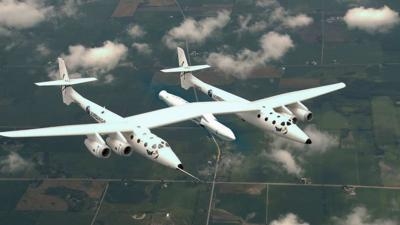Fri, Jan 16, 2015
WhiteKnightTwo Reconfigured To Carry LauncherOne
While every other gadget in our lives has gotten smaller, lighter, and cheaper, satellite technology has somehow gotten bigger, heavier, and more expensive since the days of Sputnik and Explorer I. But now, thanks to the recent advances in Cubesats and microsatellites, commercial satellite start-ups, universities, schools, and even IndieGoGo campaigns can put their own satellites into space. But small satellites need small satellite launch vehicles—after all, small satellites cannot truly change the world without cost-effective, frequent rides to space!

Current small and microsatellites reached space mostly by “hitchhiking” — catching a ride on someone else’s big, expensive rocket. But hitchhiking to space has real drawbacks: just like hitchhiking here on Earth, when you leave and where you get dropped off aren’t your decisions to make, and the driver probably has strict rules about what you can and can’t do in the vehicle. If you are just trying to prove that your satellite works in space, those restrictions may be fine, but if you are trying to build a business or accomplish a mission, you need your own ride, at the right price.
The makers, builders, and satellite entrepreneurs have done their part. It’s time for the rockets to do theirs. Sir Richard Branson says it’s time for LauncherOne.
Virgin Galactic, says they are leveraging its work building their human spaceflight program and its team’s extensive background in low-cost launch systems to create LauncherOne, an orbital launch vehicle dedicated to the small satellite market. By using much of the same infrastructure originally that supports SpaceShipTwo — in particular WhiteKnightTwo, our unique, high-performance mothership — the company says it can keep prices low while accommodating customer needs for launch availability and flexibility.
Branson said on the Virgin Galactic website that they are "hard at work finalizing the design for LauncherOne and testing its key components. LauncherOne will be a two-stage rocket, built using advanced composite structures, and powered by our new family of LOX/RP-1 liquid rocket engines. Each LauncherOne mission will be capable of delivering as much as 225 kilograms (500 pounds) to a low inclination Low Earth Orbit or 120 kilograms (265 pounds) to a high-altitude Sun-Synchronous Orbit, for a price of less than $10M. The customers we’ve already announced plan to use LauncherOne to take pictures of the Earth for humanitarian causes, to collect more accurate weather measurements, to hunt for asteroids that could represent threats and opportunities to our home planet, and to launch many other types of satellites. We’re convinced that the types of missions are only the tip of the proverbial iceberg."
More News
From 2023 (YouTube Version): Legacy of a Titan Robert (Bob) Anderson Hoover was a fighter pilot, test pilot, flight instructor, and air show superstar. More so, Bob Hoover was an i>[...]
Get The Latest in Aviation News NOW on Instagram Are you on Instagram yet? It's been around for a few years, quietly picking up traction mostly thanks to everybody's new obsession >[...]
Aero Linx: B-52H Stratofortress The B-52H Stratofortress is a long-range, heavy bomber that can perform a variety of missions. The bomber is capable of flying at high subsonic spee>[...]
Altimeter Setting The barometric pressure reading used to adjust a pressure altimeter for variations in existing atmospheric pressure or to the standard altimeter setting (29.92).>[...]
"Knowing that we play an active part in bettering people's lives is extremely rewarding. My team and I are very thankful for the opportunity to be here and to help in any way we ca>[...]
 Classic Aero-TV: Remembering Bob Hoover
Classic Aero-TV: Remembering Bob Hoover ANN FAQ: Follow Us On Instagram!
ANN FAQ: Follow Us On Instagram! ANN's Daily Aero-Linx (05.15.24)
ANN's Daily Aero-Linx (05.15.24) ANN's Daily Aero-Term (05.15.24):Altimeter Setting
ANN's Daily Aero-Term (05.15.24):Altimeter Setting Aero-News: Quote of the Day (05.16.24)
Aero-News: Quote of the Day (05.16.24)



